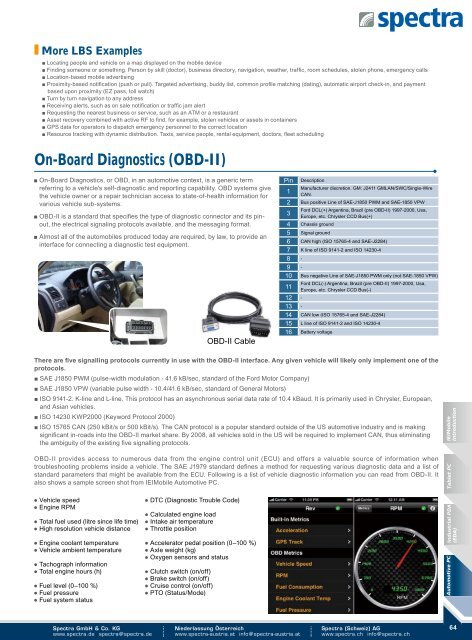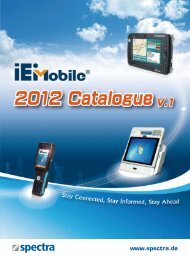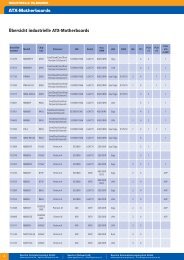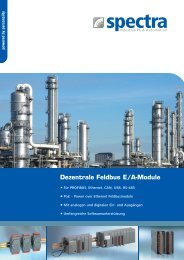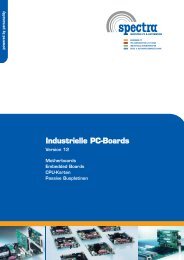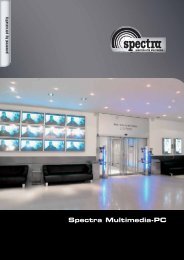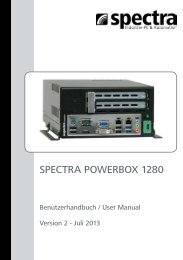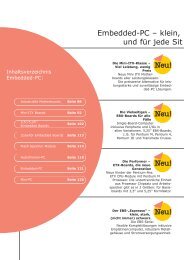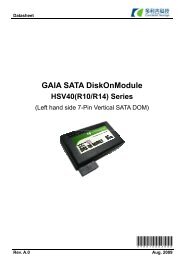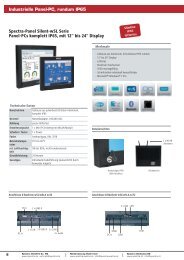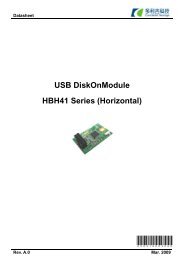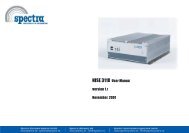Tablet PC - Spectra Computersysteme GmbH
Tablet PC - Spectra Computersysteme GmbH
Tablet PC - Spectra Computersysteme GmbH
Create successful ePaper yourself
Turn your PDF publications into a flip-book with our unique Google optimized e-Paper software.
More LBS Examples<br />
■ Locating people and vehicle on a map displayed on the mobile device<br />
■ Finding someone or something. Person by skill (doctor), business directory, navigation, weather, traffic, room schedules, stolen phone, emergency calls<br />
■ Location-based mobile advertising<br />
■ Proximity-based notification (push or pull). Targeted advertising, buddy list, common profile matching (dating), automatic airport check-in, and payment<br />
based upon proximity (EZ pass, toll watch)<br />
■ Turn by turn navigation to any address<br />
■ Receiving alerts, such as on sale notification or traffic jam alert<br />
■ Requesting the nearest business or service, such as an ATM or a restaurant<br />
■ Asset recovery combined with active RF to find, for example, stolen vehicles or assets in containers<br />
■ GPS data for operators to dispatch emergency personnel to the correct location<br />
■ Resource tracking with dynamic distribution. Taxis, service people, rental equipment, doctors, fleet scheduling<br />
On-Board Diagnostics (OBD-II)<br />
■ On-Board Diagnostics, or OBD, in an automotive context, is a generic term<br />
referring to a vehicle's self-diagnostic and reporting capability. OBD systems give<br />
the vehicle owner or a repair technician access to state-of-health information for<br />
various vehicle sub-systems.<br />
■ OBD-II is a standard that specifies the type of diagnostic connector and its pinout,<br />
the electrical signaling protocols available, and the messaging format.<br />
■ Almost all of the automobiles produced today are required, by law, to provide an<br />
interface for connecting a diagnostic test equipment.<br />
OBD-II Cable<br />
Pin<br />
1<br />
Description<br />
Manufacturer discretion. GM: J2411 GMLAN/SWC/Single-Wire<br />
CAN.<br />
2 Bus positive Line of SAE-J1850 PWM and SAE-1850 VPW<br />
3<br />
Ford DCL(+) Argentina, Brazil (pre OBD-II) 1997-2000, Usa,<br />
Europe, etc. Chrysler CCD Bus(+)<br />
4 Chassis ground<br />
5 Signal ground<br />
6 CAN high (ISO 15765-4 and SAE-J2284)<br />
7 K line of ISO 9141-2 and ISO 14230-4<br />
8 -<br />
9 -<br />
10 Bus negative Line of SAE-J1850 PWM only (not SAE-1850 VPW)<br />
11<br />
Ford DCL(-) Argentina, Brazil (pre OBD-II) 1997-2000, Usa,<br />
Europe, etc. Chrysler CCD Bus(-)<br />
12 -<br />
13 -<br />
14 CAN low (ISO 15765-4 and SAE-J2284)<br />
15 L line of ISO 9141-2 and ISO 14230-4<br />
16 Battery voltage<br />
There are five signalling protocols currently in use with the OBD-II interface. Any given vehicle will likely only implement one of the<br />
protocols.<br />
■ SAE J1850 PWM (pulse-width modulation - 41.6 kB/sec, standard of the Ford Motor Company)<br />
■ SAE J1850 VPW (variable pulse width - 10.4/41.6 kB/sec, standard of General Motors)<br />
■ ISO 9141-2. K-line and L-line. This protocol has an asynchronous serial data rate of 10.4 kBaud. It is primarily used in Chrysler, European,<br />
and Asian vehicles.<br />
■ ISO 14230 KWP2000 (Keyword Protocol 2000)<br />
■ ISO 15765 CAN (250 kBit/s or 500 kBit/s). The CAN protocol is a popular standard outside of the US automotive industry and is making<br />
significant in-roads into the OBD-II market share. By 2008, all vehicles sold in the US will be required to implement CAN, thus eliminating<br />
the ambiguity of the existing five signalling protocols.<br />
OBD-II provides access to numerous data from the engine control unit (ECU) and offers a valuable source of information when<br />
troubleshooting problems inside a vehicle. The SAE J1979 standard defines a method for requesting various diagnostic data and a list of<br />
standard parameters that might be available from the ECU. Following is a list of vehicle diagnostic information you can read from OBD-II. It<br />
also shows a sample screen shot from IEIMobile Automotive <strong>PC</strong>.<br />
● Vehicle speed<br />
● Engine RPM<br />
● Total fuel used (litre since life time)<br />
● High resolution vehicle distance<br />
● Engine coolant temperature<br />
● Vehicle ambient temperature<br />
● Tachograph information<br />
● Total engine hours (h)<br />
● Fuel level (0–100 %)<br />
● Fuel pressure<br />
● Fuel system status<br />
● DTC (Diagnostic Trouble Code)<br />
● Calculated engine load<br />
● Intake air temperature<br />
● Throttle position<br />
● Accelerator pedal position (0–100 %)<br />
● Axle weight (kg)<br />
● Oxygen sensors and status<br />
● Clutch switch (on/off)<br />
● Brake switch (on/off)<br />
● Cruise control (on/off)<br />
● PTO (Status/Mode)<br />
Automotive <strong>PC</strong> Industrial PDA <strong>Tablet</strong> <strong>PC</strong> IEIMobile<br />
(EDA)<br />
Introduction<br />
<strong>Spectra</strong> <strong>GmbH</strong> & Co. KG<br />
www.spectra.de spectra@spectra.de<br />
Niederlassung IEIMobile-Intro-2013-V10<br />
Österreich<br />
www.spectra-austria.at info@spectra-austria.at<br />
<strong>Spectra</strong> (Schweiz) AG<br />
www.spectra.ch info@spectra.ch<br />
64


